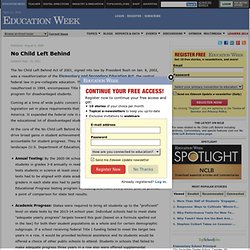

No Child Left Behind (NCLB) Home Page. Research Center: No Child Left Behind. Published: August 4, 2004 Updated Sept. 19, 2011 The No Child Left Behind Act of 2001, signed into law by President Bush on Jan. 8, 2002, was a reauthorization of the Elementary and Secondary Education Act, the central federal law in pre-collegiate education.

The ESEA, first enacted in 1965 and previously reauthorized in 1994, encompasses Title I, the federal government's flagship aid program for disadvantaged students. Coming at a time of wide public concern about the state of education, the NCLB legislation set in place requirements that reached into virtually every public school in America. No Child Left Behind Act. The No Child Left Behind Act of 2001 (NCLB)[1][2] is a United States Act of Congress that is a reauthorization of the Elementary and Secondary Education Act, which included Title I, the government's flagship aid program for disadvantaged students.[3] NCLB supports standards-based education reform based on the premise that setting high standards and establishing measurable goals can improve individual outcomes in education.

The Act requires states to develop assessments in basic skills. To receive federal school funding, states must give these assessments to all students at select grade levels. The Act does not assert a national achievement standard. Each individual state develops its own standards.[4] NCLB expanded the federal role in public education through annual testing, annual academic progress, report cards, teacher qualifications, and funding changes.[3] The bill passed in the U.S. Elementary and Secondary Education Act.